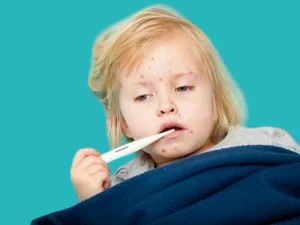Chickenpox, or varicella, is one of the most common viral diseases among children, especially younger children. It is a contagious disease that appears as a distinctive skin rash in the form of small, itchy blisters, accompanied by a high temperature and cold-like symptoms.
Although chickenpox is considered a mild illness in most cases, it can cause complications in some children if not closely and properly monitored. Therefore, it is important for parents to know its causes, symptoms, and how to treat and prevent it to protect their children.
What is chickenpox in children
It is a viral infection that affects children and is characterized by a rash in the form of red spots that develop into fluid-filled blisters, accompanied by intense itching and a high fever. The disease is usually mild in most healthy children, improving within 7-10 days. However, in some cases, especially in children with weakened immune systems, it can cause complications that require medical attention.
Common Symptoms of Chickenpox in Children

Symptoms appear 10-21 days after exposure to the infection and appear in stages:
- A mild fever.
- General fatigue.
- Loss of appetite.
- Mild body aches.
- A distinctive rash that begins with small red spots on the face or chest.
- The spots spread to the rest of the body.
- Intense itching.
- The spots turn into blisters filled with a clear fluid.
- The blisters dry up.
- Scrapes form at the site of the blisters.
What are the causes of infection and how is the disease transmitted
Chickenpox in children is caused by the varicella-zoster virus. The infection is easily transmitted to children through direct contact with the blisters, rash, or fluid inside the blisters, by contact with contaminated surfaces or objects, such as clothing and toys, that have been touched by an infected child, or by airborne droplets from an infected child's cough or sneeze.
Stages of Chickenpox in Children
- Incubation period: 10-21 days after infection, during which time the child does not show any symptoms.
- Initial symptomatic period: Lasts 2-3 days and is characterized by mild symptoms such as a slight fever, fatigue, and loss of appetite.
- Rash stage: This stage begins with small red spots that develop into blisters containing clear fluid, which then crust over.
- Healing stage: This stage occurs approximately 7-10 days after the rash appears, during which all the crusts fall off. The child is no longer contagious at this time.
What are the possible complications of chickenpox
- Bacterial skin infections. Viral or bacterial pneumonia.
- Nervous system complications such as encephalitis.
- Dehydration due to loss of appetite and high fever.
- If the mother is pregnant, this may cause serious complications affecting the fetus.
When is a child contagious
An infected child is contagious from two days before the rash appears until all blisters disappear and crust over, which is usually 7 to 10 days.
What are the treatment and home care methods for a child

- The child is given a fever reducer and a pain reliever, such as paracetamol.
- Reducing itching and soothing the skin with a warm bath in lukewarm water and using calamine lotion to relieve itching.
- Clip the child's nails to avoid scratching blisters and skin infections.
- Give the child plenty of fluids and eat soft, bland foods, especially if there are blisters in the mouth.
- The child should rest at home and self-isolate.
- If the child's immunity is weak or the infection is severe, the doctor may prescribe an antiviral medication.
- If symptoms such as a high fever, frequent vomiting, dizziness, convulsions, difficulty breathing, or a severe cough appear, it is necessary to consult a doctor.
- If the blisters appear unusual or contain pus, this is a sign of a bacterial infection and a doctor should be consulted.
Medications to Treat Chickenpox and Relieve Its Symptoms
Fever reducers and painkillers, such as paracetamol, are used first. Then, topical ointments are applied to the child's body to soothe the skin, such as calamine lotion. Mild antihistamines are also used to reduce itching, especially before bedtime. Antiviral medications may be used in severe cases.
How can a child be protected from chickenpox
- The child should be vaccinated against the disease.
- Home isolation is recommended for the infected child.
- Practice personal hygiene, such as frequent handwashing and avoiding sharing personal items.
- Avoid close contact with the infected child, especially pregnant women, the elderly, and those with weakened immune systems.
A Brief Introduction to Chickenpox in Children
Chickenpox is a contagious viral disease that affects children. However, it is usually mild. Its main characteristic is an itchy rash, along with a high fever and cold-like symptoms.The infection spreads easily, especially in schools and homes. Therefore, isolating an infected child is an essential step to protect them.
Home care, complete rest for the child, and ensuring they drink plenty of fluids are usually sufficient for complete recovery. Paracetamol is used to reduce fever and other medications to soothe the itching. Although complications are rare, vaccination against the disease remains the most important method of prevention.